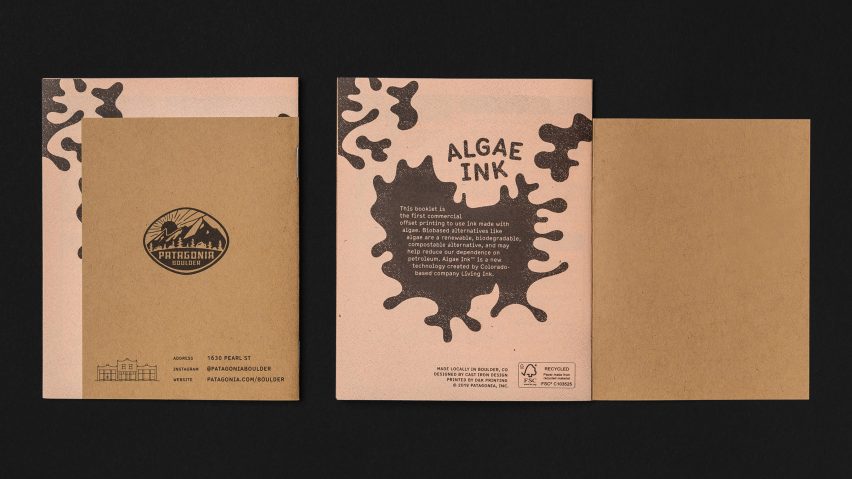Cast Iron Design has created a guide book for the city of Boulder, Colorado on recycled paper with ink made from algae.
Created for clothing company Patagonia, the city guide is printed with a black pigment that Cast Iron Design sourced from Colorado company Living Ink. It is made from a by-product of blue-green algae, spirulina.
Living Ink transforms the solid biomass, which is produced in California by Earthrise Nutritionals, into a dark pigment by a light thermal treatment that develops a black colour.
The pigment is then mixed with other materials to form the ink. The final product is made up of 20 per cent pigment, sourced from the algae biomass, 70 per cent vegetable oil and 10 per cent additives, such as defoamers and surfactants.
Cast Iron Design's guide book is printed in Boulder using a process called offset printing, in which the texts and images are transferred from a plate onto a rubber blanket, and then onto recycled paper booklet.
The local studio claims the brochure is the first time the ink and printing process has been used, and believes it could help make the print industry more sustainable.
"The potential for the technology is substantial (ie it's a big frickin' deal)," said Cast Iron Design. "Small victories like this push the industry towards a more sustainable future."
The studio added that Living Ink's algae-based substance is more natural and safer than traditional black ink, which is often produced from heavy crude oil, and generates a significant carbon footprint and is classified as potentially carcinogenic.
"Algae-based ink is significant because it replaces the petroleum-based pigments used in conventional offset ink and has a smaller carbon footprint," said Cast Iron Design.
It also believes it has the potential to be carbon negative because algae is an organism that uses photosynthesis – a process that creates energy and turns carbon dioxide into oxygen.
"Because of its photosynthesis abilities, algae ink production may actually be carbon negative – pending a proper life cycle analysis," the studio added.
"Algae is a promising pigment for many reasons, chiefly because algae, like plants, eats sunshine and carbon dioxide and produces oxygen."
The algae-based ink by Living Ink, however, is not yet available commercially and a patent is pending.
In total, 8,000 of Patagonia's Boulder Guide Books were printed. They feature single-page maps that zoom into different areas to cover both walking and driving distances in the area.
Other details include the city's animal life, seasonal activities, trails and places to eat and drink.
The city guides were printed on French Paper Co recycled paper booklets, which are produced at a facility in Michigan that has on-site hydroelectricity.
Algae-based products have become popular in the past few years, as part of a bid to make alternative designs that are more sustainable. A Vollebak T-shirt, a raincoat by Charlotte McCurdy and packaging by Margarita Talep are among the other products made with algae.
Brands Ecoalf and Native Shoes have also made sneakers with elements of the aquatic plant.

